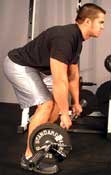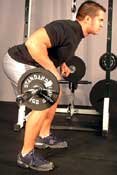For a great many bodybuilders, proper feel and technique in performing lat work comes later on in their training. Unfortunately for most it is much later. Although thickness is obtained, the width and flair of the lats lag behind. The problem is due to not employing the correct technique in performing the various movements used to widen the lats. The technique is not really natural in nature and requires understanding, and a great deal of practice to master.
The biceps come into play heavily while performing any movements for the back, especially the lats. You cant work the lats without the biceps becoming involved to a very large degree. The secret is to limit the involvement of the biceps as much as possible. Most beginners use almost only bicep strength in performing lat exercises and this limits the results they can expect to receive. The biceps, forearms, and grip must be secondary muscle actions while performing lat movements... not foremost.
The hands must be viewed as hooks or cups that hook the bar. The mind must be focused on the back executing the movement and not pulling with the biceps. For most, this is difficult to do in the beginning as you cannot ignore the fact biceps are pulling muscles and used in any pulling movement. Mind visualization and practice are required in order to perform lat exercises properly for maximum benefit.
Although this technique is to be used on all back and lat movements, let me describe it using the bent over row as an example. Assume the bent over row position. Hands on the bar about shoulder width apart, your feet slightly wider than shoulder width. Keep your knees lightly bent throughout the movement. Bend over at the waist with your upper torso slightly more than parallel to the floor. Now focus on your arms and hands being nothing more than hooks on the bar. Concentrate full on your back and start the movement with your lats, not your arms. Try to make your shoulder blades touch one another.


Bent Over Barbell Row. Your focus must be on the lats doing the work, not the arms. The only way for most bodybuilders to properly perform lat work is to practice form and technique with very light weight. Once you have mastered the technique you can then begin adding weight to your exercises. Many bodybuilders use weights that are far too heavy for performing lat movements correctly. Poor form on lat exercises only places you at higher risk for injury and prevents you from working your lats the way they should be worked.
Chins are the absolute hardest movement to perform properly. Next are bent over rows. Both are excellent lat movements and allow for varied hand spacing to hit all aspects of the lats. You should continue to practice all lat movements using light weights without worrying about anything except your form. So that you will not feel using light weights counter productive to your training, I suggest you follow this giant set routine.
You will have to use light weights to make it thorough and it will give you plenty of practice. After following this giant set for about six weeks you should have the movements down pretty good and can advance to heavier weights and fewer movements per workout.
Begin by thoroughly warming up the lats. I suggest you perform chins for two sets of ten reps. If you are unable to do ten chins dont worry about it and every two sessions try to add one more repetition. Chins are difficult for most and I would not worry about the total number of reps you can actually perform. Just keep working on them. Since this is the warm-up movement, allow yourself about two to two and a half minutes between sets and the start of your workout.
The following movements are to be performed one right after another with no rest in between exercises. Once you have completed all the exercises in the order listed, this will constitute one giant set and you are to rest for two minutes before moving on to your next giant set. Remember; focus on form and not how much weight you can lift. This routine is designed to help you achieve the feel for working the lats.
 The (late)
The (late) 
